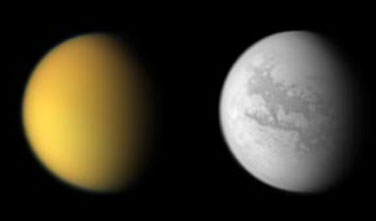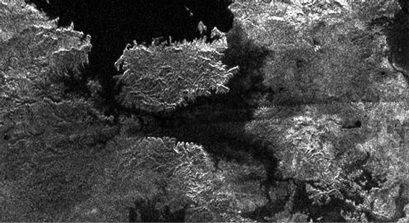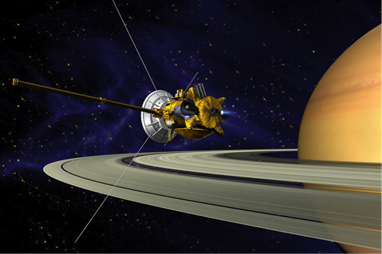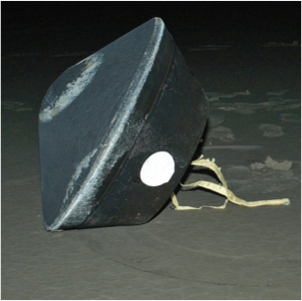-
WHAT IS NASA PHYSICS?
-
MODULES
-
Forces and Motion
-
Conservation of Momentum & Energy
-
Temperature and Heat
-
Fluids
-
Optics
-
Electromagnetic Spectrum
-
Modern Physics
-
Anticipation Guide 7
-
Intro to Modern Physics
-
Blackbody Radiation
-
The Ultraviolet Catastrophe
-
The Photoelectric Effect
-
Bohr's Atom
-
Spectra
-
Radioactive Decay
-
Special Relativity (SR)
-
Simultaneity
-
Distance and Time
-
General Relativity
-
May the Forces be with You
-
Modern Physics Notebook
-
Assessment Problems 7
-
-
Useful Things
-
-
SITE MAP
Electromagnetic Spectrum
-
Anticipation Guide
-
Light
-
No Ether
-
The Speed of Light
-
Electromagnetic Spectrum
-
Wavelength and Frequency
-
Light and Objects
-
Notebook
-
Assessment Problems
How to see HST in Orbit with your eyes.
Light and Objects
Green leaf - image from Wikipedia When light falls on an object, some of the light is reflected away, some is absorbed into the object to be radiated away later, and some may be transmitted through the object. The wavelength of the light and the properties of the object determine how much is reflected, absorbed or transmitted. If we view a leaf, it appears green to us because red wavelengths are absorbed and yellow and blue wavelengths are reflected. Our eyes can only sense wavelengths between about 400 and 700 nm (violet to red). Any wavelengths of light falling on the leaf outside this range are undetectable to us. Our brains then interpret the yellow and blue wavelengths as green light so the leaf appears green. But really its color and everything else’s depends on the wavelength of light we see it with.
When light falls on an object, some of the light is reflected away, some is absorbed into the object to be radiated away later, and some may be transmitted through the object. The wavelength of the light and the properties of the object determine how much is reflected, absorbed or transmitted. If we view a leaf, it appears green to us because red wavelengths are absorbed and yellow and blue wavelengths are reflected. Our eyes can only sense wavelengths between about 400 and 700 nm (violet to red). Any wavelengths of light falling on the leaf outside this range are undetectable to us. Our brains then interpret the yellow and blue wavelengths as green light so the leaf appears green. But really its color and everything else’s depends on the wavelength of light we see it with.
This is a very important point. Objects look different depending on the light they are reflecting or emitting. In visual wavelengths, a glass window looks quite transparent. View that same window in infrared light and it is opaque. Similarly, a standard black plastic leaf bag is opaque at visual wavelengths, but infrared light passes right through it.
Astronomers use different wavelengths of radiation to see different parts of an object. For example, Titan, Saturn’s largest moon, is shrouded in an orange haze produced by photochemistry of nitrogen and methane. That strange atmosphere blocks the view of the surface. Images of Titan taken in visible light show only the top of the yellow haze layer. To see through the haze to the surface of Titan astronomers must use detectors that can sense different wavelengths of light. Infrared light penetrates the haze but the image is still not sharp because so much light is scattered. The Cassini spacecraft includes a radar sensor that can image through the clouds, providing clear views of the surface.
Titan in visible (left) and near-infrared wavelengths. NASA images. Lakes (of liquid methane and ethane), islands, and mountains of Titan revealed by radar imaging. NASA.)
Lakes (of liquid methane and ethane), islands, and mountains of Titan revealed by radar imaging. NASA.)
Black Holes – in purple – detected in a distant galaxy by NuSTAR. NASA Image The visible and infrared energy that we receive from Titan is reflected sunlight, but other astronomical objects generate their own energy. For example, black holes – extreme concentrations of mass that have such high gravity fields that light can not escape - produce huge amounts of high energy radiation as material falls toward the hole. Some of this radiation, in the form of low energy x-rays, has been detected by orbiting spacecraft like Chandra and XMM-Newton (remember, X-rays are absorbed by our atmosphere, so telescopes on Earth can’t detect them). But higher energy x-ray photons pass right through the telescope mirrors of these spacecraft. So, a new spacecraft (NuSTAR) was launched in 2012 with denser mirrors capable of reflecting these elusive high-energy photons. Now black holes can’t hide.
The visible and infrared energy that we receive from Titan is reflected sunlight, but other astronomical objects generate their own energy. For example, black holes – extreme concentrations of mass that have such high gravity fields that light can not escape - produce huge amounts of high energy radiation as material falls toward the hole. Some of this radiation, in the form of low energy x-rays, has been detected by orbiting spacecraft like Chandra and XMM-Newton (remember, X-rays are absorbed by our atmosphere, so telescopes on Earth can’t detect them). But higher energy x-ray photons pass right through the telescope mirrors of these spacecraft. So, a new spacecraft (NuSTAR) was launched in 2012 with denser mirrors capable of reflecting these elusive high-energy photons. Now black holes can’t hide.
Atmospheric Absorption

Caption: Earth’s atmosphere blocks radiation for the wavelengths indicated in white, and wavelengths that reach Earth’s surface are shown by the colored bars that reach near the bottom of the chart show. Note that infrared radiation, which is absorbed by atmospheric water vapor, can only be detected from tall mountains. The photos of telescopes above and below the spectrum show different types of telescopes on the land, in the air and in space used to detect radiation from different parts of the EMS. HST is the Hubble Space Telescope. NASA image.
The atmosphere blocks much radiation from the Sun, stars and the rest of the universe. There are two windows in the atmosphere - in the visible and radio portions of the electromagnetic spectrum - otherwise we would not be able to see the Moon, Sun or any other astronomical objects. Earth’s atmosphere absorbs almost all high-energy radiation coming from space (UV, x-ray, gamma-ray), which is good because it is dangerous. The only way to detect parts of the EMS that are blocked is with satellites that orbit far above the atmosphere. This has an advantage for visible light observations as well, for the atmosphere is constantly in motion, distorting telescopic views.
SPACECRAFT: Observing the universe from beyond the Earth
 On October 4th, 1957, the world entered the space age with the successful launch of the USSR’s Sputnik satellite. On January 31, 1958, the United States launched Explorer 1, the first U.S. satellite. Both Sputnik and Explorer were largely technological demonstrations that rockets could be launched successfully in to space –there had been only failures before. Both spacecraft carried only limited scientific instruments, but Explorer 1 made the first major discovery of the space age – the Van Allen Radiation Belts, named after physicist James Van Allen.
On October 4th, 1957, the world entered the space age with the successful launch of the USSR’s Sputnik satellite. On January 31, 1958, the United States launched Explorer 1, the first U.S. satellite. Both Sputnik and Explorer were largely technological demonstrations that rockets could be launched successfully in to space –there had been only failures before. Both spacecraft carried only limited scientific instruments, but Explorer 1 made the first major discovery of the space age – the Van Allen Radiation Belts, named after physicist James Van Allen.
Left: Jubilant William Pickering, James Van Allen and Wernher von Braun holding a model of the Explorer 1 spacecraft.
 Since Sputnik, the USA and other nations have launched spacecraft with telescopes for sensing different portions of the electromagnetic spectrum. The most famous space telescope is the Hubble, which was launched in 1990 and has acquired hundreds of thousands of images and spectra that have revolutionized our understanding of the universe. Many other spacecraft have telescopes and instruments optimized to observe specific portions of the EMS. Typically their names identify the spectral regions they investigate: Space Infrared Telescope Facility (SIRTF), Compton Gamma Ray Observatory (CGRO), and International Ultraviolet Explorer (IUE).
Since Sputnik, the USA and other nations have launched spacecraft with telescopes for sensing different portions of the electromagnetic spectrum. The most famous space telescope is the Hubble, which was launched in 1990 and has acquired hundreds of thousands of images and spectra that have revolutionized our understanding of the universe. Many other spacecraft have telescopes and instruments optimized to observe specific portions of the EMS. Typically their names identify the spectral regions they investigate: Space Infrared Telescope Facility (SIRTF), Compton Gamma Ray Observatory (CGRO), and International Ultraviolet Explorer (IUE).

Hubble Space Telescope orbiting over Earth’s clouds. NASA Image. The Hubble is a modified Newtonian telescope with the light bouncing off the main mirror (M1), and then reflecting off a smaller one (M2) that sends it through a central hole in M1 to a focus (F) where a camera is mounted. Diagram from Wikipedia.
 The next generation orbiting telescope to follow Hubble (HST) is the James Webb Space Telescope, to be launched in 2018. The Webb will be better than the HST in two major ways. First, it will have multiple mirrors that will be 6.5 times in diameter, 2.7 times larger than the single HST mirror, allowing the Webb to detect much fainter light from near the beginning of the universe 13.7 billion years ago. The Webb sensors are optimized (including being coated with gold for better reflectance) for the infrared portion of the EMS, allowing it to see through gas clouds and measure temperatures of cool objects. To make sure it doesn’t get overheated, JWST will only observe planets in our solar system from Mars and beyond; Webb needs to be kept cold to operate effectively.
The next generation orbiting telescope to follow Hubble (HST) is the James Webb Space Telescope, to be launched in 2018. The Webb will be better than the HST in two major ways. First, it will have multiple mirrors that will be 6.5 times in diameter, 2.7 times larger than the single HST mirror, allowing the Webb to detect much fainter light from near the beginning of the universe 13.7 billion years ago. The Webb sensors are optimized (including being coated with gold for better reflectance) for the infrared portion of the EMS, allowing it to see through gas clouds and measure temperatures of cool objects. To make sure it doesn’t get overheated, JWST will only observe planets in our solar system from Mars and beyond; Webb needs to be kept cold to operate effectively.
Left: James Webb Telescope Model. NASA image.
 To study objects in our solar system, spacecraft are launched to get closer to the objects to see them better. In the early days of space operations we only had the technical ability to send spacecraft that quickly flew past the Moon and various planets. These flyby spacecraft took photos and measured magnetic fields while quickly passing the object. The Voyager 2 mission launched in 1977 was the most sophisticated flyby spacecraft that made a grand tour of the outer solar system, whizzing past Jupiter, Saturn, Uranus and Neptune. Currently, the New Horizons spacecraft is enroute to a close flyby of Pluto in 2015.
To study objects in our solar system, spacecraft are launched to get closer to the objects to see them better. In the early days of space operations we only had the technical ability to send spacecraft that quickly flew past the Moon and various planets. These flyby spacecraft took photos and measured magnetic fields while quickly passing the object. The Voyager 2 mission launched in 1977 was the most sophisticated flyby spacecraft that made a grand tour of the outer solar system, whizzing past Jupiter, Saturn, Uranus and Neptune. Currently, the New Horizons spacecraft is enroute to a close flyby of Pluto in 2015.
Right: Artist rendition of Cassini spacecraft flying over the rings of Saturn. NASA image.
 More technologically demanding are spacecraft that enter orbit around a planet. Today, the U.S. has the Cassini orbiter circling Saturn, the Messenger orbiting Mercury, and the Lunar Reconnaissance Orbiter at the Moon. Orbiters have extended periods to conduct comprehensive investigations; for example, Cassini has been orbiting Saturn since 2004 and is expected to continue through 2017.
More technologically demanding are spacecraft that enter orbit around a planet. Today, the U.S. has the Cassini orbiter circling Saturn, the Messenger orbiting Mercury, and the Lunar Reconnaissance Orbiter at the Moon. Orbiters have extended periods to conduct comprehensive investigations; for example, Cassini has been orbiting Saturn since 2004 and is expected to continue through 2017.
Left: NASA image of Stardust capsule after a parachute landing in the Utah desert.
The most detailed study of a moon or planet requires landing on its surface to sample its rocks and atmosphere directly. The US Stardust robotic spacecraft collected dust from the surface of a comet, and Japan’s Hayabusa sampled dust from an asteroid; in both cases the dust was returned to Earth for analysis.
 The largest and most complex planetary lander is the Curiosity rover, which currently is driving itself across Gale Crater on Mars. Curiosity is a traveling chemistry laboratory with ten onboard instruments (cameras, spectrometers, particle detectors, and weather sensors) looking to understand Martian geologic history and searching for signs of life.
The largest and most complex planetary lander is the Curiosity rover, which currently is driving itself across Gale Crater on Mars. Curiosity is a traveling chemistry laboratory with ten onboard instruments (cameras, spectrometers, particle detectors, and weather sensors) looking to understand Martian geologic history and searching for signs of life.
Right: Curiosity rover on Mars. NASA drawing.
 The most audacious landings ever were during the Apollo program when six spacecraft successfully landed 12 astronauts on the Moon and brought them (and lunar samples) safely back to Earth. Hopefully, men and women will return to the Moon someday and will also explore Mars. Perhaps you – if you study your physics – will be among them.
The most audacious landings ever were during the Apollo program when six spacecraft successfully landed 12 astronauts on the Moon and brought them (and lunar samples) safely back to Earth. Hopefully, men and women will return to the Moon someday and will also explore Mars. Perhaps you – if you study your physics – will be among them.
Left: Apollo 15 astronaut and rover on the Moon. When will we return? NASA Image.
© 2013 by Wheeling Jesuit University/Center for Educational Technologies®. 316 Washington Ave., Wheeling, WV 26003-6243. All rights reserved. Privacy Policy and Terms of Use.

